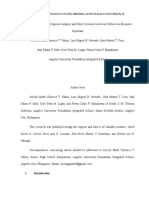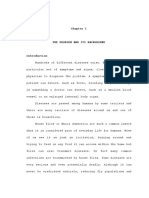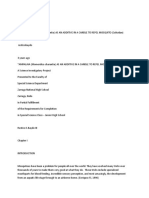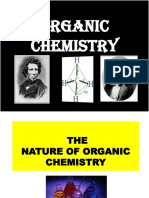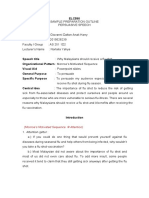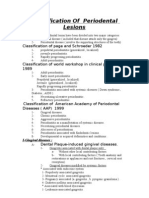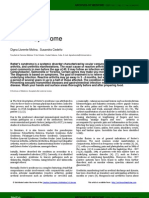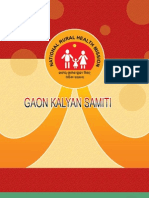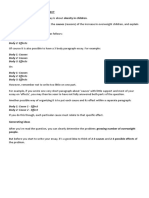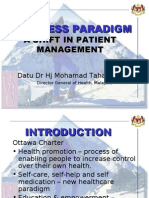0 ratings0% found this document useful (0 votes)
184 viewsLarvicidal Effect of Dalanghita (Citrus Nobilis)
Larvicidal Effect of Dalanghita (Citrus Nobilis)
Uploaded by
Shiki Asagami BrunestedThis study aims to test the effectiveness of Dalanghita peel oil extract as a larvicide against Aedes aegypti mosquitoes. The researchers will expose A. aegypti larvae to three different concentrations of Dalanghita peel oil extract (50%, 75%, 100%) and measure mortality rates after 24 and 48 hours. They hypothesize that the extracts will not have a significant larvicidal effect. If effective, Dalanghita peel extract could serve as a low-cost natural pesticide for remote areas in the Philippines. Statistical analysis using ANOVA will determine if mortality rates differ significantly between concentrations.
Copyright:
© All Rights Reserved
Available Formats
Download as PPTX, PDF, TXT or read online from Scribd
Larvicidal Effect of Dalanghita (Citrus Nobilis)
Larvicidal Effect of Dalanghita (Citrus Nobilis)
Uploaded by
Shiki Asagami Brunested0 ratings0% found this document useful (0 votes)
184 views11 pagesThis study aims to test the effectiveness of Dalanghita peel oil extract as a larvicide against Aedes aegypti mosquitoes. The researchers will expose A. aegypti larvae to three different concentrations of Dalanghita peel oil extract (50%, 75%, 100%) and measure mortality rates after 24 and 48 hours. They hypothesize that the extracts will not have a significant larvicidal effect. If effective, Dalanghita peel extract could serve as a low-cost natural pesticide for remote areas in the Philippines. Statistical analysis using ANOVA will determine if mortality rates differ significantly between concentrations.
Original Title
Larvicidal Effect of Dalanghita (Citrus nobilis).pptx
Copyright
© © All Rights Reserved
Available Formats
PPTX, PDF, TXT or read online from Scribd
Share this document
Did you find this document useful?
Is this content inappropriate?
This study aims to test the effectiveness of Dalanghita peel oil extract as a larvicide against Aedes aegypti mosquitoes. The researchers will expose A. aegypti larvae to three different concentrations of Dalanghita peel oil extract (50%, 75%, 100%) and measure mortality rates after 24 and 48 hours. They hypothesize that the extracts will not have a significant larvicidal effect. If effective, Dalanghita peel extract could serve as a low-cost natural pesticide for remote areas in the Philippines. Statistical analysis using ANOVA will determine if mortality rates differ significantly between concentrations.
Copyright:
© All Rights Reserved
Available Formats
Download as PPTX, PDF, TXT or read online from Scribd
Download as pptx, pdf, or txt
0 ratings0% found this document useful (0 votes)
184 views11 pagesLarvicidal Effect of Dalanghita (Citrus Nobilis)
Larvicidal Effect of Dalanghita (Citrus Nobilis)
Uploaded by
Shiki Asagami BrunestedThis study aims to test the effectiveness of Dalanghita peel oil extract as a larvicide against Aedes aegypti mosquitoes. The researchers will expose A. aegypti larvae to three different concentrations of Dalanghita peel oil extract (50%, 75%, 100%) and measure mortality rates after 24 and 48 hours. They hypothesize that the extracts will not have a significant larvicidal effect. If effective, Dalanghita peel extract could serve as a low-cost natural pesticide for remote areas in the Philippines. Statistical analysis using ANOVA will determine if mortality rates differ significantly between concentrations.
Copyright:
© All Rights Reserved
Available Formats
Download as PPTX, PDF, TXT or read online from Scribd
Download as pptx, pdf, or txt
You are on page 1of 11
Group Leader: Contreras, Christian Alexis L.
Group Members: Mendova, Andrea C.
Santos, Joshua Troy
Suarez, Viva Gia T.
Tolentino, Ma. Elaisa M.
Introduction
Mosquitoes have always been a danger that people have to deal with. A
mosquito bite can transmit Dengue and it can also transmit the Zika virus,
Chikungunya virus, Malaria virus, Rickettsia infection and other various
parasites and diseases they harbor. Larvicide however can be quite costly for
the remote areas in the Philippines. 20 kilograms of Larvicide can go range
from P7920, if imported from outside the country.
With these facts, the researchers found that citrus fruits such as
Dalanghita are of high medicinal value because of their multiple uses, such
as in the food industry, cosmetics and folk medicine. Dalanghita peel oil
extract which contains a considerable amount of limonene, has numerous
applications including natural insect repellent for use on humans. Their
waste such as their peelings can be used in the production of other by-
products. The researchers would like to prove that the dalanghita peel oil
extract can be economically viable and effective answer to the mosquito
proliferation to prevent another outbreak occurs.
Statement of the Problem
What is the mortality rate for the A. aegypti larvae
using Dalanghita peel oil extract after 24 hours? And
48 hours of exposure period?
Which of the following extract concentrations would
exhibit optimum larvicidal effect? (50% g/mL, 75%
g/mL, 100% g/mL)
Is the dalanghita peel oil extract effective in being a
larvicidal agent against Aedes aegypti larvae?
Statement of Hypothesis
Ho: Dalanghita peel oil extracts will
not leave a significant effect as a
larvicide in the 50%, 75%, and
100% extract in all concentrations.
Conceptual Framework
(Schematic Diagram)
Significance of the Study
For the people in the Medical Field, this study
will provide these people with basic knowledge and
information as to the potential use of natural
pesticide.
For the students, this study will provide
information for them to become critical thinkers.
For the researchers, this study will provide an
open opportunity for the future researchers to
conduct further investigation related to the
problem.
Scope and Delimitation
of the Study
• This study aims to use the peelings of dalanghita as
an alternative larvicidal agent.
This study will only focus on the effectiveness of
the dried peelings of dalanghita as a larvicidal. The
researcher does not aim to analyze other possible
outcomes that can be done with the dalanghita
peel.
Method of Research
Research Design
The study uses an experimental method
of research which includes:
* collection of plant sample
* collection of plant extraction
The result shows proof of the larvicidal
effect Dalanghita peel oil extracts towards
Aedes aegypti larvae.
Methods of Research
Instrumentation and Validation
The researchers will use dalanghita fruits that will be
collected from Calamba market and will be
authenticated by the botanist of the Botanical
Herbarium of the University of the Philippines Los
Baños Laguna.
The Aedes aegypti larvae will be purchased and verified
from the Institute of Biological Sciences of the
University of the Philippines Los Baños Laguna.
The dalanghita peels will be extracted using Soxhlet
apparatus that are made of Pyrex glass, with high
thermal resistance
Statistical Analysis
The statistical tools were employed for the
analysis and interpretation of data. The one-way
analysis of variance (ANOVA) is used to determine
whether there are any statistically significant
differences between the means of two or more
independent (unrelated) groups. This will be used
to determine if there is significant difference in
mortality rate among different dalanghita peel
extract concentrations.
You might also like
- Bug MonologueDocument1 pageBug MonologueMike Parisi0% (1)
- Fruit Extract (Capsicum Frutescens) As Coackroaches KillerDocument17 pagesFruit Extract (Capsicum Frutescens) As Coackroaches KillerKristine Jill Fuentes LlegueNo ratings yet
- Phlebotomy 2Document125 pagesPhlebotomy 2Shiki Asagami BrunestedNo ratings yet
- Latihan Soal Asking For Attention and Checking UnderstandingDocument4 pagesLatihan Soal Asking For Attention and Checking UnderstandingKevin Chandra100% (1)
- Lansium Domesticum Corr. Leaf Extract Spray As Bioinsecticide For Aedes Aegypti Mosquito ControlDocument9 pagesLansium Domesticum Corr. Leaf Extract Spray As Bioinsecticide For Aedes Aegypti Mosquito ControlPeterson RonquilloNo ratings yet
- Larvicidal Activity of Vitex Negundo Linn. (Lagundi) Against Mosquito LarvaeDocument13 pagesLarvicidal Activity of Vitex Negundo Linn. (Lagundi) Against Mosquito LarvaeVannesa RabaNo ratings yet
- Makabuhay IpDocument7 pagesMakabuhay IpButterflyCalmNo ratings yet
- Chapter 1Document8 pagesChapter 1verboseNo ratings yet
- Practical Research 2Document13 pagesPractical Research 2Joy Dela CruzNo ratings yet
- ORGANIC-INSECTICIDES g10Document5 pagesORGANIC-INSECTICIDES g10Ann N. ArcillaNo ratings yet
- 1 Potency of Oregano (Origanum Vulgare) and Basil (Ocimum Basilicum) Extracts As Mosquito RepellantDocument7 pages1 Potency of Oregano (Origanum Vulgare) and Basil (Ocimum Basilicum) Extracts As Mosquito RepellantMaikaNo ratings yet
- Lemon Peel (Citrus Limon) and Lagundi (Vitex Negundo) Extracts As Potential Mosquito LarvicideDocument33 pagesLemon Peel (Citrus Limon) and Lagundi (Vitex Negundo) Extracts As Potential Mosquito LarvicideMys TiqueNo ratings yet
- The Repellency of Cymbopogon Citratus Stapf As 1 Solution 3 BenefitsDocument20 pagesThe Repellency of Cymbopogon Citratus Stapf As 1 Solution 3 BenefitsAngie Lou BacorNo ratings yet
- Final Thesis Write UpsDocument55 pagesFinal Thesis Write Upskingsaber860No ratings yet
- Research Sci. 4Document21 pagesResearch Sci. 4Jayson Yalung06No ratings yet
- AbstraDocument21 pagesAbstraKethlin Manimtim BignoteaNo ratings yet
- The Feasibility of Calamansi and Onion Extract As A Cockroach Killer (Group 2)Document5 pagesThe Feasibility of Calamansi and Onion Extract As A Cockroach Killer (Group 2)JeremyNo ratings yet
- Calamansi As Alternative LarvicideDocument2 pagesCalamansi As Alternative LarvicideSaiko ChiNo ratings yet
- Full Manuscript AlejocalustrofloresDocument107 pagesFull Manuscript AlejocalustrofloresLyca jean PascuaNo ratings yet
- Revise Research 1Document32 pagesRevise Research 1Charity CotejoNo ratings yet
- Capstone Revised 3Document32 pagesCapstone Revised 3Jasmine PatronaNo ratings yet
- S.I.P. Chapter 2Document4 pagesS.I.P. Chapter 2Joseph Benedict M. DeLeonNo ratings yet
- Chapter 1Document4 pagesChapter 1Samdenver AbrazadoNo ratings yet
- Capsicum Frustascens Cayenne Pepper Decoction As An Alternative Killer For CockroachesDocument4 pagesCapsicum Frustascens Cayenne Pepper Decoction As An Alternative Killer For CockroachesRhitzelynn Ann BarredoNo ratings yet
- Manuscript FinalDocument44 pagesManuscript FinalLoulou ApolloNo ratings yet
- TH 412Document43 pagesTH 412Zeus De claroNo ratings yet
- Background of The StudyDocument4 pagesBackground of The Studysaraheyyy100% (1)
- Dried Flower of KamansiDocument6 pagesDried Flower of KamansiJustine Lacerona100% (1)
- GROUP 5 FINAL RESEARCH PAPER - Docx 2Document14 pagesGROUP 5 FINAL RESEARCH PAPER - Docx 2af.026010No ratings yet
- Chapter 2.docx (Unfinished 75%) PDFDocument5 pagesChapter 2.docx (Unfinished 75%) PDFAce JohnNo ratings yet
- ResearchhDocument17 pagesResearchhjeryquilNo ratings yet
- Review of The Related LiteratureDocument6 pagesReview of The Related LiteratureMiharu KimNo ratings yet
- Revised 2Document20 pagesRevised 2Mikah Kaye Demafelis100% (1)
- Herbal Plants As An Ant Repellent 246-242-1-PbDocument4 pagesHerbal Plants As An Ant Repellent 246-242-1-Pbsiu manmanNo ratings yet
- Format Hardcopy For Research ProposalDocument19 pagesFormat Hardcopy For Research ProposalKeisha Zafra100% (1)
- Antibacterial Potential of Dimocarpus Longan Imrad StyleDocument26 pagesAntibacterial Potential of Dimocarpus Longan Imrad StyleWilliam ColeNo ratings yet
- The Model For Use of Chemicals by Sugarcane Farmers For Reducing Health and Environmental Impacts in ThailandDocument5 pagesThe Model For Use of Chemicals by Sugarcane Farmers For Reducing Health and Environmental Impacts in ThailandInternational Journal of Innovative Science and Research TechnologyNo ratings yet
- Mosqil RepellentDocument40 pagesMosqil RepellentjangsobriagaNo ratings yet
- The Effectiveness of Lemongrass As A Natural RepellentDocument6 pagesThe Effectiveness of Lemongrass As A Natural RepellentJohn Vincent Calleja100% (1)
- SCIENCE INVESTIGATORY PROJECTfinalDocument12 pagesSCIENCE INVESTIGATORY PROJECTfinaljean marie russel bravoNo ratings yet
- Chapter I 3is 1Document17 pagesChapter I 3is 1doronilafatima100% (1)
- Drina Chapter IIDocument35 pagesDrina Chapter IIDrina PaglinawanNo ratings yet
- UntitledDocument49 pagesUntitledJhanella Marie DalmanNo ratings yet
- Chapter 123 Insect Repellent SoapDocument61 pagesChapter 123 Insect Repellent SoapRyan Lorenzo Garcia PerezNo ratings yet
- ANTIMICROBIAL ACTIVITY OF OREGANO (Origanum Vulgare L.) AND BASILDocument6 pagesANTIMICROBIAL ACTIVITY OF OREGANO (Origanum Vulgare L.) AND BASILJaime TerrazoNo ratings yet
- New ResearchDocument9 pagesNew Researchjesusa moranNo ratings yet
- Investigatory Project (Natural Mosquito Repellent)Document3 pagesInvestigatory Project (Natural Mosquito Repellent)LYKA FAUSTONo ratings yet
- Investigatory ProjectDocument6 pagesInvestigatory Projectknixau67% (3)
- Organic Insect RepellentDocument11 pagesOrganic Insect RepellentCailah Sofia Selauso100% (1)
- Effectiveness of OreganoDocument5 pagesEffectiveness of OreganoMuhaimen SalikNo ratings yet
- Lemongrass, Hot Chili Pepper As Fly RepellentDocument21 pagesLemongrass, Hot Chili Pepper As Fly RepellentZhaira PimentelNo ratings yet
- Acceptability of LemongrassDocument13 pagesAcceptability of LemongrassMarinette MedranoNo ratings yet
- Ampalaya RepellentDocument30 pagesAmpalaya RepellentKyla Sofia BenedictoNo ratings yet
- III3 FinalManuscriptDocument54 pagesIII3 FinalManuscriptYESORYES0% (1)
- Pampanga High School: LARVICIDAL ACTIVITY OF PANSIT-PANSITAN (Peperomia Pellucida) Leaf Extract Against Aedes AegyptiDocument12 pagesPampanga High School: LARVICIDAL ACTIVITY OF PANSIT-PANSITAN (Peperomia Pellucida) Leaf Extract Against Aedes AegyptiGinaNo ratings yet
- Presented To The Academe Of: A Research ProposalDocument33 pagesPresented To The Academe Of: A Research ProposalTae-tae LachimolalaNo ratings yet
- Chapter IIDocument7 pagesChapter IIMark PollenteNo ratings yet
- LARVICIDAL EFFECT OF AMPALAYA (Momordica Charantia) FRUIT JUICE ON Aedes MOSQUITO LARVAEDocument53 pagesLARVICIDAL EFFECT OF AMPALAYA (Momordica Charantia) FRUIT JUICE ON Aedes MOSQUITO LARVAERajesh Kumar Asunala57% (7)
- Group 5 Research 1-5Document23 pagesGroup 5 Research 1-5Lone KnightNo ratings yet
- Chapter 5Document3 pagesChapter 5Danny De LeonNo ratings yet
- Quantitative StudyDocument16 pagesQuantitative StudyDave Vincent IsipNo ratings yet
- (Momordica Charantia), AND SUNFLOWER (Heliantus Annus) LEAFDocument24 pages(Momordica Charantia), AND SUNFLOWER (Heliantus Annus) LEAFHeart Divine DeloviarNo ratings yet
- Larvicidal Effect of Dalanghita Citrus NobilisDocument13 pagesLarvicidal Effect of Dalanghita Citrus NobilisShiki Asagami BrunestedNo ratings yet
- Cardiac Function: Unice L. Padilla, RMT, MSMTDocument15 pagesCardiac Function: Unice L. Padilla, RMT, MSMTShiki Asagami BrunestedNo ratings yet
- Larvicidal Effect of Dalanghita Citrus NobilisDocument13 pagesLarvicidal Effect of Dalanghita Citrus NobilisShiki Asagami BrunestedNo ratings yet
- Alcohol, Phenols, Thiol & EtherDocument35 pagesAlcohol, Phenols, Thiol & EtherShiki Asagami BrunestedNo ratings yet
- ALDEHYDES & KETONES BlueDocument16 pagesALDEHYDES & KETONES BlueShiki Asagami BrunestedNo ratings yet
- 1 Organic Chem IntroDocument97 pages1 Organic Chem IntroShiki Asagami BrunestedNo ratings yet
- ALKANES2Document41 pagesALKANES2Shiki Asagami BrunestedNo ratings yet
- Diarrhoea in PediatricsDocument89 pagesDiarrhoea in PediatricsKimbek BuangkeNo ratings yet
- Elc Persuasive Speech PDFDocument6 pagesElc Persuasive Speech PDFGiovanni Andrew DaltonNo ratings yet
- Latina_Farmworkers_1730694800207550843167284e903f36cDocument8 pagesLatina_Farmworkers_1730694800207550843167284e903f36csuyashgupta1818No ratings yet
- Finish Line of The Preparation Is The End of Tooth PreparationDocument36 pagesFinish Line of The Preparation Is The End of Tooth PreparationAnureet MehrokNo ratings yet
- Evidencereport 4Document2 pagesEvidencereport 4api-242810131No ratings yet
- Articulo de InvestigacionDocument8 pagesArticulo de Investigacionjai_santiago_rojasNo ratings yet
- Scaling-Up Cervical Cancer Prevention Program in Mozambique PowerpointDocument17 pagesScaling-Up Cervical Cancer Prevention Program in Mozambique PowerpointJhpiegoNo ratings yet
- Classification of Periodental LesionsDocument6 pagesClassification of Periodental LesionsAsia IbraheemNo ratings yet
- Essay OutlineDocument2 pagesEssay OutlineHana MohamedNo ratings yet
- Reiter S SyndromeDocument4 pagesReiter S SyndromeInternational Medical PublisherNo ratings yet
- Lesson Deconstructing Web PagesDocument0 pagesLesson Deconstructing Web Pagesapi-242096123No ratings yet
- Pestilens BattalionsDocument4 pagesPestilens BattalionsAnonymous 7X4Py5uqNo ratings yet
- Academic Writing IIDocument41 pagesAcademic Writing IIzagad04No ratings yet
- Is Smoking Good For UsDocument3 pagesIs Smoking Good For UsChatryn_msNo ratings yet
- Bacillaceae Spores, Fungi and Aflatoxins Determination in HoneyDocument4 pagesBacillaceae Spores, Fungi and Aflatoxins Determination in HoneyxducheNo ratings yet
- Gaon Kalyan SamitiDocument24 pagesGaon Kalyan SamitiArpit GuptaNo ratings yet
- Antpyretic-Analgesic and Antinlammatory DrugsDocument38 pagesAntpyretic-Analgesic and Antinlammatory DrugskasondaNo ratings yet
- BullDocument7 pagesBullhawkssensNo ratings yet
- IELTS Writing - Cause and EffectDocument6 pagesIELTS Writing - Cause and Effectdeathnote lNo ratings yet
- k12 - Asma Dan PpokDocument59 pagesk12 - Asma Dan PpokMukti NurriyadiNo ratings yet
- ALTB and PneumoniaDocument22 pagesALTB and PneumoniaSiti Nursuhada binti Mohd AminNo ratings yet
- Recent Global Epidemiology in StrokeDocument73 pagesRecent Global Epidemiology in StrokeratuhamimNo ratings yet
- Michael Goss Death CertificateDocument1 pageMichael Goss Death Certificateapi-239096088No ratings yet
- Sample Paper 1Document26 pagesSample Paper 1anubha srivastavaNo ratings yet
- Activity#3 - CPHM121 - Danielle C. - MD 1y2-3Document2 pagesActivity#3 - CPHM121 - Danielle C. - MD 1y2-3DCRUZNo ratings yet
- Persia Americana, Commonly Called As The Avocado, Is A Tropical, Frost-Intolerant EvergreenDocument2 pagesPersia Americana, Commonly Called As The Avocado, Is A Tropical, Frost-Intolerant EvergreenLeunice RiegoNo ratings yet
- Wellness ParadigmDocument20 pagesWellness ParadigmUjangNo ratings yet
- ApplicationForm AP3Document1 pageApplicationForm AP3Clash Of Clans Master100% (4)










